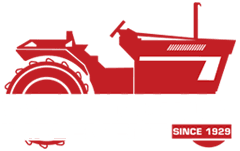Kuhn GA 15231

Features
HEAVY-DUTY COMPONENTS
Heavy-Duty Components for Superior Raking
Masterdrive® GIII Gearbox
The patented KUHN Masterdrive GIII double-reduction gearbox is designed for heavy crops, tough field conditions, and intensive use. Key components have been improved to build lighter, yet stronger rotors such as: aluminum alloy housings, optimized cam track minimizing force on the follower bearing, larger follower bearing diameter reducing rotation speed and pressure on the cam, tine arms with large-dimension bearings, sturdier pivoting tine support shaft, reinforced main shaft, and reinforced mounting of tine arms on tine holders. The Masterdrive GIII’s ability to move heavy wet crop, handle dry hay gently, and neatly windrow forage is unrivaled in the industry.
Double-Curved Tine Arms
Hyper-tangential, double-curved tine arms are designed to form fluffy and straight windrows for superior raking quality at higher speeds. Fluffy windrows allow more air movement through the crop promoting fast and uniform drying!
KUHN rotary rakes achieve this by following two basic principles for ideal windrow formation. First, the tine arms maintain a positive forward position right up to the point where the forage is delivered to the windrow ensuring gentle crop handling and minimal ash incorporation. Second, a steep cam track allows the tines to be raised very quickly to provide additional clearance over the windrow.
3D Rotor Articulation
Suspended on an articulation joint and independent from the main frame, the rotors can pivot in all directions allowing close ground following over undulating terrain. The tines collect the crop with the greatest precision.
Jet Effect
A hydraulic cylinder at the front of the rotor head controls the “touchdown” when lowering the rotor. In a similar way to an airplane, the rear touches first with the front following. This ensures that the tines do not strike the soil.
EASY WORKING ADJUSTMENTS
Quick and Easy Working Adjustments
Smart Headland Management
For easy and efficient headland turns at the end of the field, an automated pre-programmed headland sequence can be utilized on the ISOBUS monitor. The headland sequence can be adapted to specific needs and thanks to angle sensors, the rotors will always be raised to the pre-defined height regardless of working width. Once all pre-adjustments are done, you only need to press a button, then sit back and let the electronics do the work.
Adjustable Working Width
The working width is adjusted from the ISOBUS monitor, making this adjustment easy for the operator. The front rotors can be moved independently from the rear rotors to choose a desired working width. Then adjust your rear rotors to create a windrow width to best match your harvesting equipment.
Raking Height Adjustment
The raking height is easily adjusted from the operator’s seat. This can be done simultaneously for the two front or the two rear rotors, as well as individually for each single one. The current height is indicated both on the terminal’s display and the rotor undercarriage.
INCREASE YOUR WORKING POWER
Hydraulics to Increase the Machine’s Working Power
Self-Contained Hydraulic Unit
The hydraulic unit of the GA 13231 and GA 15231 is mounted on the pivoting headstock of the machine frame. In this way the primary drive shaft is always aligned to the tractor, even in tight corners. Moreover, you can adapt the PTO speed from the cab according to type and volume of forage. The hydraulic drive considerably simplifies the machine and provides multiple solutions for improved work.
Boost Function
From the ISOBUS monitor, the rotation speed of the front rotors can be increased by 20% compared to the rear rotors. The boost function projects the forage toward the center of the machine, spreading the forage across the width of the rear rotor. This puts less stress on the rear rotor, allowing them to create a fluffy and uniform windrow. This is ideal for perfecting the forage drying process.
Specs
| SPECIFICATIONS | |
| MODEL | GA 15231 |
| Working width | 31'2" - 48'3" (9.5 - 14.7 m) |
| Windrow width | 4'7" - 8'2" (1.4 - 2.5 m) |
| Transport width | 9'10" (3.0 m) |
| Length | 35'9" (10.9 m) |
| Transport height | 13'1" (4.0 m) |
| Number of rotors | 4 |
| Rotor diameter | 2 x 12'4" (3.8 m) and 2 x 13'1" (4.0 m) |
| Number of tines per tine arm | 4 |
| Number of tine arms | Fixed, 13 in front, 15 on rear |
| Fully enclosed gearbox | Masterdrive GIII |
| Ground adaptation | 3D suspension |
| Working height adjustment | Standard via ISOBUS |
| Rotor flotation | Constant hydraulic suspension, automatically adjusted according to the working width (standard on front rotors) |
| Individual working width adjustment of the front rotors | Standard via ISOBUS |
| Spare rotor wheel | 2 as standard |
| Tires | 4 tires per rotor, 18 x 8.50-8 |
| Transport tires | 600/50R-22.5 |
| Machine control | via ISOBUS terminal |
| Rotor drive | Self-contained hydraulic |
| PTO speed | 1,000 rpm |
| PTO shaft | 1 3/8" - 21-spline |
| Hitch | 2-point, Cat. 2 and 3N |
| Minimum PTO power requirement | 114 hp (85 kW) |
| Required tractor hydraulic connections | LS connection: 1 x Pressure, 1 x Free return, 1 x load sensing |
| Required tractor electrical connections | 1 x 7 pin light connection, ISOBUS plug, 12V power |
| Road lights and signaling | Standard |
| Machine net weight approx. | 13,670 lbs (6,200 kg) |
| Brakes | Hydraulic |

